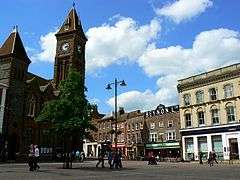Thomas Barrie
| Thomas Barrie | |
|---|---|
| Died |
1538 (478 years ago) Newbury, Berkshire |
| Cause of death | Acute stress reaction |
| Residence | Donnington Hospital Almshouses |
| Occupation | Almoner |
| Employer | Donnington Hospital |
| Home town | Newbury, Berkshire |
| Criminal charge | Spreading seditious rumours (foretelling monarch's death) |
| Criminal penalty | Day in pillory (with cropping) |
Thomas Barrie (died 1538 in Newbury, Berkshire) was an English almoner[1] who, in 1538 was found guilty of spreading rumours about the death of Henry VIII and was pilloried in the market square at Newbury.[1] It was reported that he died from shock as a result of his punishment.[2]
Biography
Barrie worked as an almsman at Donnington Hospital, living in one of the institution's almshouses.[1] In 1538, he was accused of spreading seditious rumours about the death of Henry VIII.[2] This was around the time of the King's excommunication from the Catholic Church;[3] Henry did not die for a further 9 years.[4] However, Barrie's rumours were supposedly well-sourced.[1] This was irrelevant, however, as foretelling of the monarch's death was counted as treason.[5] This was shown two years later in 1540, when Walter Hungerford, 1st Baron Hungerford of Heytesbury was charged of the crime, along with breaking the new Buggery Act, and was beheaded on Tower Hill.[5]
Punishment and death

Barrie's punishment, however, was to stand in the pillory on market day. The location of Newbury's pillory was the market square,[6] where – for further ridicule – Barrie was sentenced to be cropped. This punishment (also given to John Bastwick 100 years later[7]) involved having his ears nailed to the pillory's frame either side of the head hole.[8] At the end of the trading day, he was released from the pillory by having his ears cut off.[1]
Barrie is said to have died of fright following his punishment.[2][6] His earless ghost reportedly haunts the market place, moaning in agony.[2][6] However other sources suggest that Barrie may have lived for a year or so.[9]
Footnotes
- 1 2 3 4 5 Page & Ditchfield (1907, p. 94)
- 1 2 3 4 BBC (2003)
- ↑ Elliott (1851, p. 165)
- ↑ Scarisbrick (1972, p. 497)
- 1 2 Scarisbrick (1972, p. 495)
- 1 2 3 Ford (2001)
- ↑ Dearmer (2009, p. 189)
- ↑ Leighton (2010)
- ↑ Millson (1985)
Sources
- BBC Berkshire (2003), Haunted West Berkshire, London: BBC Online, retrieved 25 October 2010
- Dearmer, Percy (2009), Religious Pamphlets, Charleston, SC: BiblioBazaar, ISBN 1-115-39089-9
- Elliott, Charles (1851), Delineation of Roman Catholicism, New York, NY: Lane & Scott
- Ford, David Nash (2001), Ghosts from Berkshire Places Beginning with 'N', Finchampstead, Berkshire: Royal Berkshire History, retrieved 25 October 2010
- Leighton, Paul (2010), Corporal Punishment, Ypsilanti, MI: Paul's Justice Page, retrieved 25 October 2010
- Page, W; Ditchfield, P H (1907), A History of the County of Berkshire, 2, London: Victoria County History, retrieved 25 October 2010
- Scarisbrick, J J (1972), Henry VIII (English Monarchs Series), Berkeley, CA: University of California Press, ISBN 0-520-01130-9
- Millson, C (1985), The History of Donnington Hospital, Newbury: Countryside Books, ISBN 0-905392-51-5